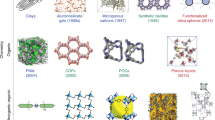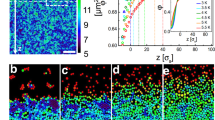Abstract
PREVIOUS investigations have shown that porous modifications of the surfaces of glasses may be formed by the action of liquid water1 and water vapour2. I have now studied the formation of porosity in the surface of grains of soda–lime–silica glass in various conditions.
This is a preview of subscription content, access via your institution
Access options
Subscribe to this journal
Receive 51 print issues and online access
$199.00 per year
only $3.90 per issue
Buy this article
- Purchase on SpringerLink
- Instant access to full article PDF
Prices may be subject to local taxes which are calculated during checkout
Similar content being viewed by others
References
Sewell, P. A., Glass Tech., 8, 108 (1967).
Sewell, P. A., and Morgan, A. M., Nature, 215, 325 (1967).
Kiselev, A. V., The Structure and Properties of Porous Materials, Colston Papers (edit. by Everett, D. H., and Stone, F. S.), (Butterworths, London, 1958).
Davydov, V. Ya., Kiselev, A. V., and Zhuravlev, L. T., Trans. Farad. Soc., 60, 2254 (1964).
Makrides, A. C., J. Phys. Chem., 63, 1789 (1959).
Liberti, A., Sixth Intern. Symp. Gas Chromatography, 1966 (Institute of Petroleum, 1967).
Author information
Authors and Affiliations
Rights and permissions
About this article
Cite this article
SEWELL, P. Porous Layers at Glass Surfaces. Nature 217, 441–442 (1968). https://doi.org/10.1038/217441a0
Received:
Revised:
Published:
Issue date:
DOI: https://doi.org/10.1038/217441a0
This article is cited by
-
Revealing the surface structural cause of scratch formation on soda-lime-silica glass
Scientific Reports (2022)



